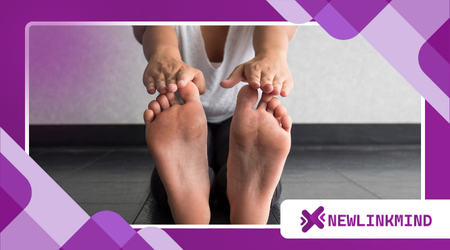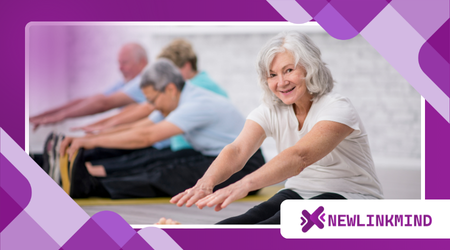Yoga for Beginners Who Can’t Touch Their Toes

Yoga for Beginners Who Can’t Touch Their Toes is a completely accessible starting point.
Anúncios
Many people shy away from yoga, believing a prerequisite is the ability to tie themselves into a pretzel.
This misconception couldn’t be further from the truth. Flexibility, after all, is a journey, not a destination. It’s an evolution of the body and mind.
Why is Touching Your Toes So Difficult for Many?
The struggle to reach one’s toes stems from several factors. Tight hamstrings are the usual culprits. These muscles run along the back of your thighs.
Daily habits, like prolonged sitting, shorten these crucial muscles over time. However, it’s not just the hamstrings.
Anúncios
The stiffness might involve the lower back and the gluteal muscles. Everything in the body connects through a complex kinetic chain.
A lack of mobility in the hips also plays a significant role in this limitation. This intricate network means stretching one area often benefits another.
Remember that every body is unique in its structure. Skeletal variations affect your range of motion.
Anúncios
Someone might have naturally shorter hamstrings. Don’t compare your progress to others. The practice is an internal one.
Can I Still Practice Yoga If I’m Not Flexible?
Absolutely, your current flexibility level is irrelevant. Yoga is about meeting your body where it is today. It offers modifications for every single pose.
The goal isn’t the perfect-looking pose. The true focus is the feeling and the breathing within the posture.
Think of flexibility like a credit score. It’s something you build over time through consistent, smart effort.
You wouldn’t expect a perfect score overnight. Similarly, your body needs gentle, repeated encouragement.
Ignoring your present limitations only hinders progress. Acknowledge the tension without judgment.
This non-judgmental awareness is a core principle of yoga. The breath acts as your primary tool.
What are the Best Beginner Yoga Poses to Improve Hamstring Flexibility?
Starting with foundational poses, or asanas, builds a safe base. These simple movements gently invite length back into tight areas.
Avoid forcing yourself into deep stretches initially. Listen to your body’s signals.
How Does Supported Forward Fold Help Me?
Instead of straining to reach the floor, use props. A Supported Standing Forward Fold (Uttanasana) uses a chair or blocks.
Read more: Yoga Challenges You Can Do Without Leaving the House
Place your hands on them, keeping your spine long. This modification allows the hamstrings to release gradually without undue stress on the back.
It’s a powerful pose for gently lengthening the entire back line of the body.

Why is Half Splits (Ardha Hanumanasana) So Effective?
Half Splits targets one hamstring at a time, making it highly effective. From a kneeling position, extend one leg forward.
++ How to Track Your Progress with Yoga at Home
Keep your back straight, and you’ll feel the stretch. Use blocks under your hands for better balance and support. This pose is less intense than a full forward fold.
How Can I Use Props in Seated Poses?
For Seated Forward Fold (Paschimottanasana), sit on the edge of a folded blanket or block. This small elevation tilts your pelvis forward.
This simple adjustment instantly changes the angle of the stretch. It helps to prevent rounding the lower back, ensuring a safe stretch. Alternatively, use a strap around the soles of your feet.
The Science Behind Improving Flexibility
Consistency is the real magic ingredient. Studies show that regular stretching leads to physiological changes.
A 2021 review published in the Journal of Strength and Conditioning Research highlighted the effectiveness of regular static stretching.
It found that holding stretches for 30-60 seconds multiple times a week significantly increases range of motion.
When you stretch regularly, you affect the stretch reflex. This reflex is a defense mechanism that causes the muscle to contract when it feels overstretched.
Over time, your nervous system becomes accustomed to the new range. It allows the muscles to lengthen safely.
This adaptation doesn’t happen overnight. It requires patience and non-violence (Ahimsa), another key yogic principle.
See how interesting: Starting Meditation in Retirement: A Journey of Inner Peace
Trying to force a stretch is counterproductive and risks injury. Gentle, persistent effort is the intelligent way forward.
Practical Modifications for Yoga for Beginners Who Can’t Touch Their Toes
Understanding modifications is key to a sustainable practice. Every pose has a less intense version.
Never feel embarrassed to use the tools available to you. Blocks, blankets, and straps are your allies.
| Pose Name | Common Struggle | Beginner Modification |
| Standing Forward Fold (Uttanasana) | Can’t reach the floor without rounding the back. | Place hands on blocks or a chair seat. Bend knees deeply. |
| Seated Forward Fold (Paschimottanasana) | Tight hamstrings pulling on the lower back. | Sit on a folded blanket or cushion. Loop a strap around feet. |
| Downward-Facing Dog (Adho Mukha Svanasana) | Heels won’t touch; arms/shoulders feel strained. | Bend knees deeply and lift heels. Focus on a straight spine. |
Consider an example. If you’re practicing Downward-Facing Dog, and your heels are far from the floor, bend your knees.
This allows you to prioritize the length in your spine. A long spine is always more important than straight legs. This slight bend protects your lower back.
Another example is in Triangle Pose (Trikonasana). Instead of trying to touch the floor with your hand, place your hand high up on your shin.
Better yet, use a block outside your foot. This ensures your torso stays open and aligned. This simple adjustment maintains the integrity of the pose.
Do you truly need to touch your toes to be a ‘real’ yogi? Of course not.
The true measure of a yoga practice is not how far you can stretch, but how steady you can keep your mind. It is about the connection between breath and movement.

The Mental and Emotional Benefits of the Practice
The journey of increasing flexibility is also a mental one. Yoga for Beginners Who Can’t Touch Their Toes teaches profound patience.
It encourages self-acceptance and reduces performance anxiety. You learn to be present with the sensation.
Consistency is the most vital aspect of the practice. Practicing even three 20-minute sessions per week yields better results.
This is superior to one long, aggressive hour-long session. It’s the small, repeated efforts that rewire the body.
Yoga for Beginners Who Can’t Touch Their Toes
Embrace the journey of flexibility with kindness and intelligence. Your inability to touch your toes is merely a starting point.
It’s an invitation to explore your body’s potential safely. Yoga for Beginners Who Can’t Touch Their Toes is a welcoming space for growth.
This practice is accessible, non-competitive, and profoundly personal. Start where you are, breathe deeply, and watch your body surprise you.
Frequently Asked Questions
How long will it take to be able to touch my toes?
Progress varies greatly depending on consistency and your body’s unique structure.
With regular practice (3-5 times a week), most beginners notice a significant difference in hamstring openness within 6 to 12 weeks.
Should I feel pain when stretching?
No. You should feel a deep, significant stretch sensation, often described as intensity, but never a sharp or stabbing pain. If you feel pain, back off immediately.
Do I need special equipment to start?
No. A yoga mat is helpful, but you can use a towel on a non-slip surface. Books can substitute for yoga blocks initially. A belt or scarf can work as a yoga strap.
Is it better to practice yoga in the morning or evening?
Both times have benefits. Morning practice can energize you for the day. Evening practice can release tension and prepare you for sleep.
The best time is simply the time you can practice consistently.
